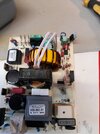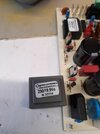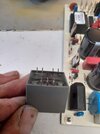Hi
Please see attached photos. This is 12v battery charger, 230v to 14v Leisure Battery Charger.
The charger has failed, and I'm trying to help my customer by repairing it rather than replacing the whole unit.
After testing I think this transformer is the cause. As you can see the sooting of the pcb, and the damage on the underside of the block.
I can't find any information about this component. There is no writing on it other than the label you can see. Nordelectronica don't respond even to engineers like myself, they told me that themselves!!
Help would be appreciated.
Please see attached photos. This is 12v battery charger, 230v to 14v Leisure Battery Charger.
The charger has failed, and I'm trying to help my customer by repairing it rather than replacing the whole unit.
After testing I think this transformer is the cause. As you can see the sooting of the pcb, and the damage on the underside of the block.
I can't find any information about this component. There is no writing on it other than the label you can see. Nordelectronica don't respond even to engineers like myself, they told me that themselves!!
Help would be appreciated.



